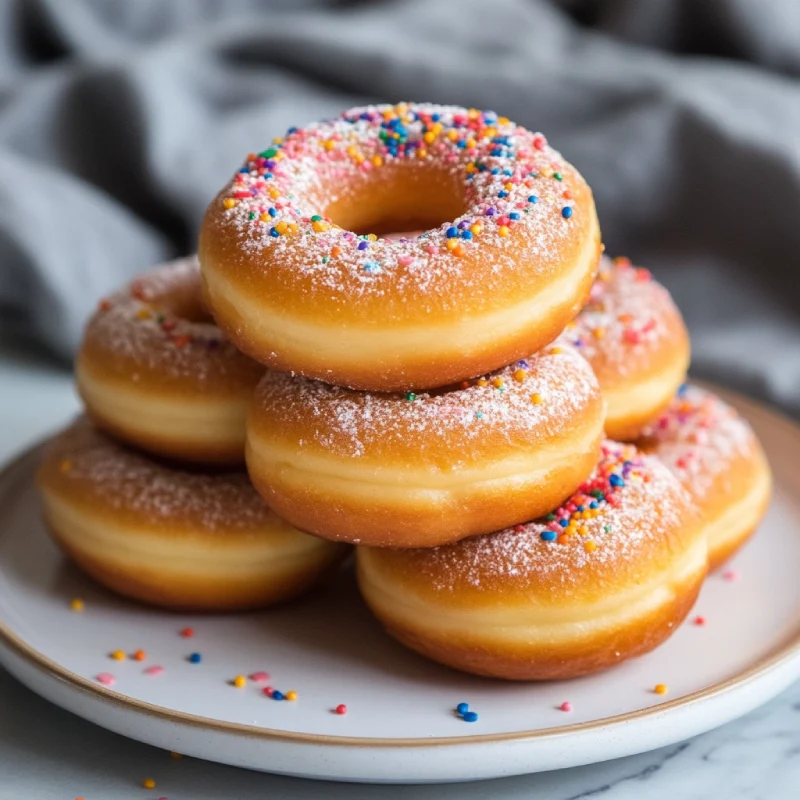Introduction to Donut Making with a Donut Maker
Using a donut maker to whip up fresh, delicious donuts at home has gained substantial popularity due to its convenience and efficiency. This handy appliance simplifies the donut-making process, allowing even novice bakers to create perfect, evenly cooked donuts in just minutes. Unlike traditional frying methods, which can be messy and require more cooking skill, a donut maker provides a clean and easy alternative with consistent results.
There are various types of donut makers available, ranging from basic models that make one or two donuts at a time to more advanced versions that can handle a larger batch. Some are designed for mini donuts, while others can produce full-sized ones. Most models are electric and feature non-stick surfaces for easy release and cleanup, making them an excellent choice for quick breakfasts, fun snacks, or entertaining guests.
Basic Donut Recipe Using a Donut Maker
Creating donuts at home can be a delightful and satisfying experience, especially with a donut maker. This basic recipe is perfect for anyone looking to whip up a quick batch of homemade donuts. Here’s how to do it:
Ingredients
- Flour: 2 cups all-purpose flour
- Sugar: 1/2 cup granulated sugar
- Baking Powder: 1 1/2 tablespoons
- Milk: 1 cup, room temperature
- Eggs: 2 large
- Butter: 1/4 cup, melted
Step-by-Step Instructions
- Mix Dry Ingredients: In a large mixing bowl, sift together the flour, sugar, and baking powder. This ensures there are no clumps and the baking powder is evenly distributed.
- Combine Wet Ingredients: In a separate bowl, whisk the eggs, milk, and melted butter until the mixture is smooth.
- Combine Mixtures: Gradually add the wet ingredients to the dry ingredients, stirring until the batter is smooth and free of lumps.
- Prepare the Donut Maker: Preheat your donut maker according to the manufacturer’s instructions. Lightly grease the molds with a little butter or non-stick spray.
- Fill the Molds: Carefully spoon or pipe the batter into the donut molds, filling each one about three-quarters full to allow room for the donuts to rise.
- Bake: Close the lid and bake for about 4 to 6 minutes or until the donuts are golden and spring back when touched.
- Cool and Decorate: Allow the donuts to cool slightly before removing them from the maker. Then, decorate as desired with glazes, powdered sugar, or cinnamon sugar.
Tips for Perfect Donuts
- Batter Consistency: The batter should be thick but still pourable, similar to pancake batter. If it’s too thick, add a little more milk; if too runny, add a bit more flour.
- Avoid Overfilling: Filling the molds too much can cause the donuts to lose their shape. If you’re unsure, it’s better to underfill at first and adjust as needed.
- Troubleshooting Common Issues: If donuts are cooking unevenly, check to ensure the donut maker is level and getting consistent heat. For donuts that are too dry, try reducing the cooking time slightly.
This basic donut recipe can serve as a foundation for numerous variations, allowing you to add your own creative flavors and toppings.
Advanced Donut Recipes for Donut Maker
Elevate your home donut-making with these advanced recipes that introduce rich flavors and cater to diverse dietary needs. Whether you crave chocolate or need a vegan option, these ideas will enhance your donut repertoire.
Chocolate Mini Donuts
- Ingredients: Incorporate cocoa powder into your standard batter for a rich chocolate taste and fold in chocolate chips for extra sweetness and texture.
- Preparation: Prepare the chocolate batter by adding 1/4 cup of cocoa powder to your basic donut recipe. Mix in a handful of chocolate chips before baking in your donut maker.
- Serving Suggestions: Once baked, these mini chocolate donuts can be glazed with chocolate sauce or dusted with powdered sugar for an extra touch of decadence.
Cinnamon Sugar Donuts
- Ingredients: Simple cinnamon and sugar create a classic coating that brings a comforting warmth to each bite.
- Coating Options: Mix granulated sugar with cinnamon in a shallow dish. Brush freshly baked donuts with melted butter and toss them in the cinnamon-sugar mixture to coat evenly.
- Flavor Variations: Add a dash of nutmeg or cardamom to the cinnamon-sugar mix for a spicy twist.
Vegan and Gluten-Free Options
- Substitutes for Standard Ingredients:
- Vegan: Replace eggs with applesauce or a commercial egg replacer, and use plant-based milk and butter alternatives.
- Gluten-Free: Swap regular flour for a gluten-free all-purpose blend that is suitable for baking.
- Preparation Tips: Ensure that the batter consistency remains similar to the original recipe to maintain the quality of the donuts. You may need to adjust the amount of milk alternative to achieve the right texture.
These variations not only add diversity to your donut-making but also make it possible for everyone, regardless of dietary restrictions, to enjoy a delicious, freshly made treat.
Nutritional Insights: Caloric Content and Healthier Ingredient Swaps for Donuts
Donuts are a beloved treat worldwide, but their nutritional content, especially when store-bought, can be a concern for health-conscious individuals. Understanding the caloric content and potential for healthier ingredient swaps can enhance the enjoyment of donuts without the guilt.
Caloric Content of Typical Donuts
- Standard Donuts: A typical donut from a bakery or grocery store can range from 250 to 500 calories, primarily depending on size, ingredients, and toppings. Ingredients like chocolate, cream fillings, or glazes significantly increase calorie count.
- Mini Donuts: Smaller, bite-sized donuts typically contain fewer calories, ranging from 60 to 100 calories each, making them a more portion-controlled option.
Healthier Ingredient Swaps
- Reducing Sugar: Substitute granulated sugar with natural sweeteners like honey, maple syrup, or even apple sauce to reduce processed sugar intake and add nutritional value.
- Alternative Flours: Using whole grain, oat, or almond flour instead of white flour adds fiber and reduces the glycemic index, which can help manage blood sugar levels.
- Baking Instead of Frying: Opting to bake donuts rather than frying them cuts down significantly on fat content. A donut maker, which essentially bakes the donuts, is a great tool for this healthier preparation method.
Benefits of Homemade Donuts
- Control Over Ingredients: Making donuts at home allows for complete control over what goes into them, enabling the reduction of sugar, fat, and unwanted additives found in many store-bought versions.
- Freshness and Flavor: Homemade donuts can be made without preservatives and taste fresher. Plus, you can experiment with flavor combinations and toppings based on personal preference and nutritional goals.
FAQs: Donut Maker Maintenance and Baking Tips
Ensuring your donut maker is well-maintained and understanding how to store your donuts and tackle common baking issues can significantly enhance your baking experience.
Cleaning and Maintenance
- After Each Use: Allow the donut maker to cool completely before cleaning. Wipe the cooking surfaces with a damp, soft cloth or sponge to remove any crumbs or residue.
- Stubborn Residues: For tougher stains, use a mild, soapy water solution and a non-abrasive sponge. Avoid harsh cleaners or scrubbers that can damage the non-stick surface.
- Regular Checks: Periodically check the appliance for any wear or electrical issues, especially around the cord and heating elements.
Storage Tips for Fresh Donuts
- Short-Term Storage: Keep donuts fresh by storing them in an airtight container at room temperature for up to two days.
- Long-Term Storage: For longer storage, wrap donuts individually in plastic wrap and place them in a freezer-safe bag. Frozen donuts can last up to three months. Thaw at room temperature before serving.
Common Baking Problems
- Undercooked Donuts: If donuts are consistently undercooked, increase the cooking time slightly, or check if the donut maker is closing properly and heating to the correct temperature.
- Overly Dense Donuts: Overmixing the batter can lead to dense donuts. Mix just until the wet and dry ingredients are combined. Ensure your leavening agents (like baking powder) are fresh to help donuts rise and become fluffy.
Conclusion: Mastering Donut Making with a Donut Maker
Throughout this article, we’ve explored the delightful world of making donuts with a donut maker, from basic recipes to more advanced techniques and variations. Using a donut maker not only simplifies the process but also opens up a world of creativity, allowing you to customize flavors and cater to different dietary needs.
- Versatility and Convenience: The donut maker is a versatile tool that helps you create delicious treats quickly and with less mess than traditional frying methods.
- Creativity in the Kitchen: Experimenting with different ingredients and recipes enhances your culinary repertoire and allows you to serve up fresh, customized donuts that are sure to impress family and friends.
We encourage you to use the tips and recipes provided to experiment and find your perfect donut recipe. Whether you’re making a classic chocolate donut or venturing into vegan and gluten-free options, the possibilities are endless.

